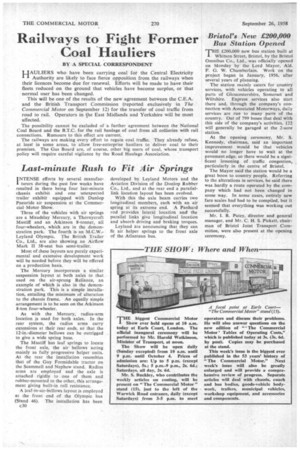Railways to Fight Former
Page 96

If you've noticed an error in this article please click here to report it so we can fix it.
Coal Hauliers
BY A SPECIAL CORRESPONDENT HAULIERS who have been carrying coal for the Central Electricity Authority are likely to face fierce opposition from the railways when their licences become due for renewal. Efforts will be made to have their fleets reduced on the ground that vehicles have become surplus, or that normal user has been changed.
This will be one of the results of the new agreement between the C.E.A. and the British Transport Commission (reported exclusively in The Commercial Motor on September 12) for the transfer of coal traffic from road to rail. Operators in the East Midlands and Yorkshire will be most affected.
The possibility cannot be excluded of a further agreement between the National Coal Board and the B.T.C. for the rail haulage of coal from all collieries with rail connections. Rumours to this effect are current.
The railways are making every effort to regain coal traffic. They already refuse, at least in some areas, to allow free-enterprise hauliers to deliver coal to their premises. The Gas Board are, of course, other big users of coal, whose transport policy will require careful vigilance by the Road Haulage Association.
Last-minute Rush to Fit Air Springs
IINTENSE efforts by several manufacturers during the past few weeks have resulted in there being four last-minute chassis exhibit and one unexpected trailer exhibit equipped with Dunlop Pneuride air suspension at the Commercial. Motor Show.
Three of the vehicles with air springs are a Maudslay Mercury, a Thornycroft Mastiff and an Atkinson 8-tonner, all four-wheelers, which are in the demonstration park. The fourth is an M.C.W.Leyland Olympic. The British Trailer Co., Ltd., are also showing an Airflow Mark II 58-seat bus semi-trailer.
Most of these layouts are purely experimental and extensive development work will be needed before they will he offered on a production basis.
The Mercury incorporates a similar suspension layout at both axles to that used on the air-sprung Reliance, an example of which is also in the demonstration park. This is a simple installation, entailing the minimum of alteration to the chassis frame. An equally simple arrangement is to be seen on the Atkinson 8-ton four-wheeler.
As with the Mercury, radius-arm location is used for both axles. In the rear system, the radius arms carry extensions at their rear ends, so that the 12-in.-diameter bellows can be outrigged to give a wide spring base.
The Mastiff has leaf springs to locate the front axle, the air bellows acting mainly as fully progressive helper units. At the rear the installation resembles that of the Guy Formidable tractor on the Scammell and Nephew stand. Radius arms are employed and the axle is attached rigidly to one of them and rubber-mounted to the other, this arrangement giving built-in roll resistance.
A leaf-in-air-bellows layout is employed at the front end of the Olympic bus (Stand 46). The installation has been c30 developed by Leyland Motors and the Aviation Division of the Dunlop Rubber Co., Ltd., and at the rear end a parallellink location layout has been evolved.
With this the axle beam carries two longitudinal members, each with an air spring at its extreme end. A Panhard rod provides lateral location and the parallel links give longitudinal location and absorb driving and braking torques.
Leyland are announcing that they can fit air helper springs to the front axle of the Atiantean bus.












































































































































































































































































































































